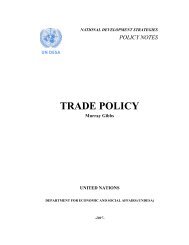Best Policy Practices
Best Policy Practices
Best Policy Practices
You also want an ePaper? Increase the reach of your titles
YUMPU automatically turns print PDFs into web optimized ePapers that Google loves.
<strong>Best</strong> <strong>Policy</strong> <strong>Practices</strong><br />
Applying voluntary consensus standards<br />
United States<br />
The text refers to certification systems;<br />
if you want to learn more, please click<br />
www.usgbc.org/LEED/ or see also<br />
Chapter 10 in this publication.<br />
The National Technology Transfer and Advancement Act<br />
(NTTAA) requires Federal agencies to “use technical standards<br />
that are developed or adopted by voluntary consensus<br />
standards bodies” in both their procurement and rulemaking<br />
unless such use is inconsistent with applicable law or otherwise<br />
impractical. In cases where no voluntary consensus<br />
standards exist, agencies can also use other technical standards.<br />
There was great wisdom in the NTTAA. Consumers benefit<br />
from standards in that they provide confidence in the quality,<br />
safety, and reliability of a product or service. Businesses<br />
benefit from standards in that they reduce cost, provide interoperability,<br />
promote regulatory compliance, reduce liability exposure,<br />
and provide organizations with a competitive advan-<br />
tage. Governments benefit from standards in that they achieve<br />
public policy objectives for a host of environmental concerns,<br />
lower regulatory and procurement costs, promote exports,<br />
trade, and economic growth, and comply with the World Trade<br />
Organization (WTO).<br />
Green building standards are at the forefront of environmental<br />
preferability standards in many ways: taking a holistic,<br />
systems approach; pushing the science of life cycle assessment;<br />
asking the tough questions about chemicals of concern;<br />
and balancing environmental, economic, and social considerations.<br />
And, the leaders in developing green building standards<br />
are engaging stakeholders in a very open, transparent process.<br />
These standard methodologies, rating systems, and other<br />
metrics provide a larger framework in which to organize and<br />
implement green programs at the national level. The use of<br />
green building standards fits well in the government context,<br />
considering the Federal government’s massive size, hierarchical<br />
structure, and typical way of doing business. The use of<br />
green building standards will also make the job of implementation<br />
easier, reducing the duplication of background research<br />
by the many parties working on green building, and giving an<br />
35
















